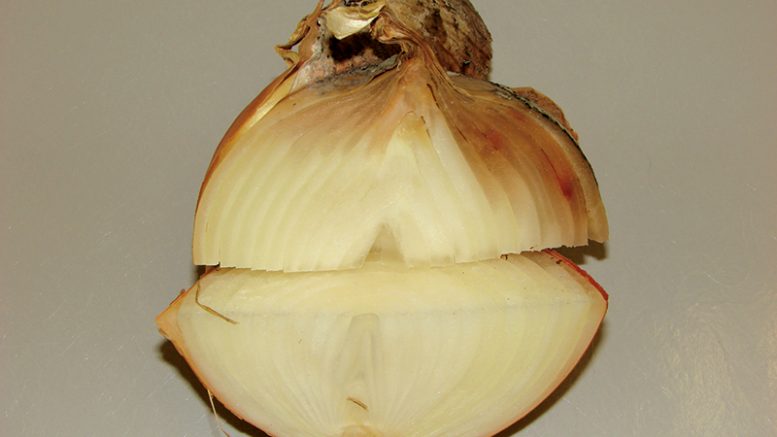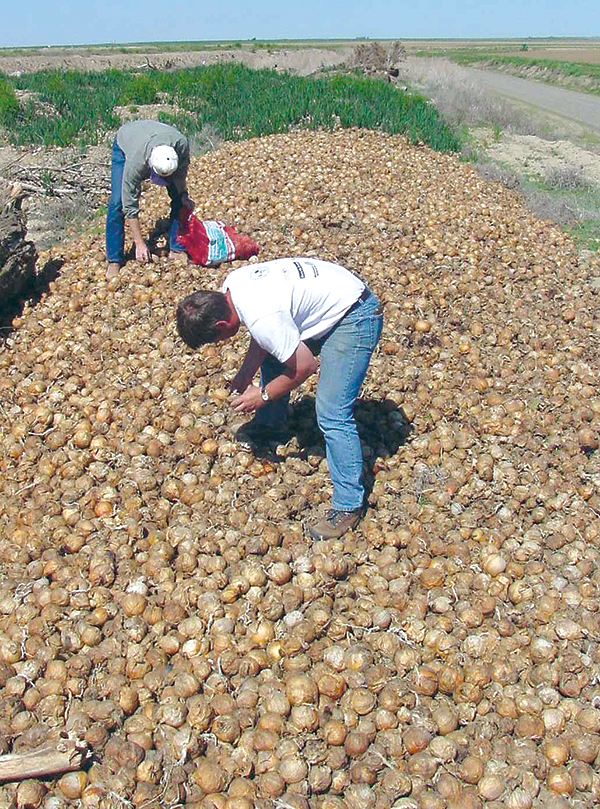Often, problems that show up in storage are a reflection of what happened in the field. In the case of Botrytis neck rot, understanding the key risk factors for the disease and improving upon practices to reduce the risk can help keep the disease out of your onions.
Botrytis neck rot typically is a postharvest storage disease of onion and, in the U.S., is caused primarily by Botrytis aclada and Botrytis allii. Symptoms usually begin at the neck and the top of the bulb, where affected tissues soften, become slightly water-soaked and turn a light brown color. Over time, the decay may move down the bulb if conditions remain favorable for growth of the pathogen. White to gray-brown mycelium and dark brown sclerotia may develop between infected scales. Severe infections can result in losses of more than 60 percent, but losses to this disease typically are very sporadic and commonly less than 5 percent.
Botrytis neck rot is different from Botrytis leaf blight, caused by Botrytis squamosa. Botrytis leaf blight is primarily a concern in areas of onion production with high relative humidity and rainfall and is very rarely seen in semi-arid regions of onion production in the western U.S., even when overhead irrigation is used.
Risk Factors
Fungi, including Botrytis species that cause neck rot and Aspergillus niger which causes black mold, and various bacteria can all present challenges in storage for onion growers. With any of these organisms, moisture in the neck of the onion is a key factor that initiates the risk for rot.
Temperature then determines which organism might become a problem. Botrytis is favored by cool to moderate temperatures. It can grow at temperatures from 50 degrees Fahrenheit up to the mid-80s, growing best in the 60s and 70s. Aspergillus and bacteria, on the other hand, are favored by higher temperatures. If the weather is cool and necks get wet – from rainfall or irrigation – when they should be drying late in the season, Botrytis is more likely to cause problems. Warmer weather, combined with moisture in the necks, can bring on black mold or bacterial infections.
Irrigation methods can also come into play. Overhead-irrigated crops are particularly at higher risk for these bulb-rotting pathogens because moisture accumulates in the neck with each pass of the pivot. Larger necks on more mature crops further increase risk.
With the combination of cooler temperatures and moisture, Botrytis spores that land on the foliage or neck of the plant germinate and form a latent infection on healthy tissue. The high-risk period comes as the tops go down close to harvest. When the tissue in the neck begins dying, the plant no longer has actively resistant cells in the neck tissues that can defend against the presence of the pathogens. Latent infections become active as the necks senesce, and if moisture remains in the necks or on the leaves, the infections can move into the top of the bulbs, leading to bulb rot in storage.
Management
“These neck rot organisms – bacteria, Aspergillus and Botrytis – are everywhere. Growers aren’t going to escape the presence of these organisms,” says Lindsey du Toit, a Washington State University vegetable seed pathologist. “So the question is how do you protect the crop from becoming affected?”
du Toit says it is critical to understand the risk factors for onion neck rot and other bulb rots, especially in the late part of the growing season, during field curing and going into storage, and to minimize risk during this window of high susceptibility.
To shorten the window of susceptibility, growers should avoid excessive nitrogen fertilization and irrigation so that necks dry quickly. Pushing fertility and irrigation late in the season in an effort to increase bulb size increases the risk of latent infections in the neck and leaves becoming active and moving into the bulb.
Good coverage with appropriate fungicides late in the season, especially just before the tops start to fall over, should make a significant difference in controlling Botrytis, du Toit says. Fungicides can be applied as a seed treatment, but the most important applications are just prior to, and during, natural senescence of the tops, or immediately after injury to the crop from events such as hailstorms or transplanting. du Toit recommends spraying fungicides that have locally systemic activity and making sure the products are effective against Botrytis.
Other management recommendations include starting with pathogen-free seed or treated seed, maintaining a rotation of at least three years between onion crops, managing onion volunteers and culls, and, most importantly, minimizing crop injury. Undercutting bulbs at the appropriate time so that roots stop taking up moisture from the soil helps hasten field curing, which shortens the duration of the most vulnerable stage for infection of the necks. The later the variety matures, the more critical undercutting becomes as the necks of these varieties tend to be drying during cooler fall conditions, which slows the curing period and increases the window of susceptibility, du Toit adds.
Finally, remember that holding healthy, well-cured bulbs in cold, dry storage lessens the risk of neck rot. Field cure only if conditions are dry. If there’s concern about moisture in the neck when bulbs are harvested, consider forced-air curing.
Lessons
“Most of the time, Botrytis neck rot is not a major problem for our growers in the Columbia Basin,” du Toit says, estimating that Botrytis is problematic in the Pacific Northwest about once every five years. “But every now and then, there will be a disaster. And every time this has happened, when I’ve had a conversation with the farm about the circumstances in that particular field that had a disaster, you can always find something that increased the risk dramatically.”
This might include specific environmental factors or production practices. A late-season rain, cool fall temperatures, irrigating too late in the season, applying too much nitrogen fertilizer, applying nitrogen fertilizer too late in the season or forgoing a late-season fungicide spray can all raise the risk level to allow the disease to be more severe than usual.
To illustrate, du Toit offers this example of how changing a production practice can make conditions more favorable for Botrytis neck rot. A grower who usually saw 5 percent neck rot in some of his red onions reported 20 to 30 percent infection one year. It was not a particularly bad year for neck rot in the region environmentally, and he used drip irrigation, which normally is very low risk for neck rot. However, at the end of this particular season, he decided to combine multiple operations into a single task to minimize the number of passes through the field. In one pass, he topped the onions, applied water to loosen the soil and pulled up the irrigation drip tape.
“I admire the ingenuity, efficiency and economy of scale, but in doing so, he created the perfect storm,” du Toit says.
Topping the onions created wounding. Pulling up the drip tape disturbed the soil and inoculum of Botrytis and other pathogens in the soil. The water added to the soil to facilitate removal of the drip tape wet the freshly wounded tops, and conditions became highly favorable for neck rot.
“The lesson is to recognize what you can control and recognize what drives these pathogens so when you’re implementing a change, we jokingly say ‘you have to think like the pathogen.’ That’s in essence what we’re telling you to do is to recognize what conditions favor the pathogen,” du Toit advises. “It’s hard because there are a lot of pathogens out there, and they aren’t all favored by the same combination of things. But the common theme across all these bulb rotting pathogens is moisture. Moisture is very high risk, but it has to be combined with the right temperatures and/or wounding.”
Story by Denise Keller, Editor
Photos courtesy Lindsey du Toit, Washington State University





